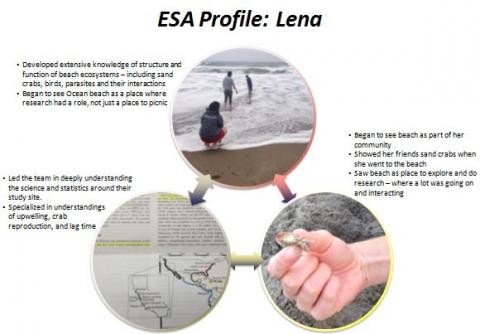Slideshow: Examining the Role of Environmental Science Learning and Agency in YCCS
Colin Dixon, Heidi Ballard, & Emily Harris (2016) Youth-Focused Community and Citizen Science: Examining the Role of Environmental Science Learning and Agency. Presentation in Symposium: “Community based science learning: Models to make classroom learning relevant to students everyday lives.” American Educational Research Association Annual Meeting. Washington, DC.
Community and citizen science (CCS) with youth participants is rapidly expanding, but very little research has addressed the ways participation in environmental research and monitoring (in this case) impacts youth understanding and use of science, nor their engagement and civic action with their community. Studies of learning outcomes for citizen science in general has primarily consisted of survey research via online questionnaires (Jordan et al. 2011, Brossard et al. 2009), which rarely reveal the particular activities or processes through which participants learn. Our purpose was therefore to examine case studies of youth-focused community and citizen science to closely examine the ways youth participate in the programs as well as how they engage with the science on their own terms, in the context of working on local conservation science research.
View the slideshow and speaking notes here.
Perspective(s) or theoretical framework
We adapt Basu and Barton’s (2009) concept of critical science agency to frame the development of science understanding and agency through participation in environmental research and monitoring. Specifically, we look at the relationship between CCS and science by focusing on the youth participants’ environmental science agency (ESA) as a foundation for change at individual, organization and ecosystem levels. ESA combines not only disciplinary understanding of environmental science and inquiry practices, but also the youths’ identification with those practices and their belief that the ecosystem is something on which they can act.
Methods, techniques, or modes of inquiry
We examine two programs, each implemented across two sites (one in-school and one out-of-school setting) in the San Francisco Bay Area (one focused on beach monitoring and one on water quality monitoring) involving youth ages 14-18 years. Each implementation site is treated as a case study (Yin 2009).
Data sources, evidence, objects, or materials
We qualitatively analyze in-depth observations and pre- and post-program interviews with youth and educators. Specifically, we conducted participant observations for all events, field trips and classroom time in which youth were doing the work of the CCS program (between 6 and 25 observation days per case). We conducted pre and post-program semi-structured interviews with between 3 and 10 youth per program, for a total 30 interviews, and with 6 educators and CCS program leaders. We also analyzed youth-generated blogs, professional posters, field notebooks and classroom assignments.
Results and/or substantiated conclusions or warrants for arguments/point of view
Through critical analysis of the perspectives and observations of youth across the four case studies, we found that youth develop different aspects of environmental science agency in different contexts, particularly. We also found that when youth were peripheral to the social-ecological system, learning was focused on exposure to new components of, and developing interest in, that system. In contrast, youth working within the hyper-local scales were able to transform a familiar landscape into a scientific learning lab with potential for environmental action.
Scientific or scholarly significance of the study or work
We use these findings of how youth develop ESA to identify key factors for youth-focused CCS for science and environmental education as well as conservation outcomes, specifically, by providing opportunities for youth to take responsibility for the quality of the data collected in leadership roles, and to allow youth multiple avenues for youth to track the use of their data for real science and environmental management decisions
References
Basu, Sreyashi Jhumki, and Angela Calabrese Barton. “Critical physics agency: Further unraveling the intersections of subject matter knowledge, learning, and taking action.” Cultural Studies of Science Education 4.2 (2009): 387-392.
Bonney, R., Cooper, C. B., Dickinson, J., Kelling, S., Phillips, T., Rosenberg, K. V., & Shirk, J. (2009). Citizen science: a developing tool for expanding science knowledge and scientific literacy. BioScience, 59(11), 977-984.
Jordan, R. C., Gray, S. A., Howe, D. V., Brooks, W. R., & Ehrenfeld, J. G. (2011). Knowledge gain and behavioral change in citizen‐science programs.Conservation Biology, 25(6), 1148-1154.
Yin, R. K., (2009). Case study research: Design and methods, 3rd Edition. Los Angeles, CA: Sage.









